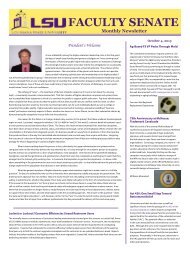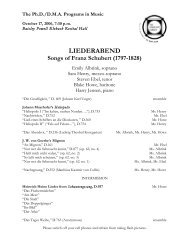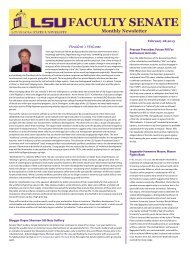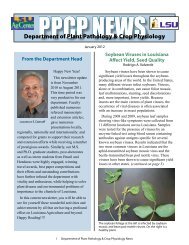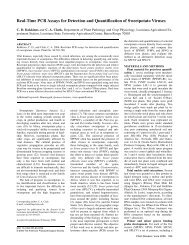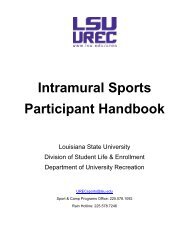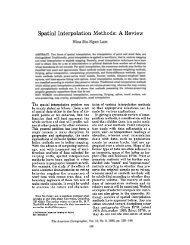María Elena Placencia/Carmen García (eds.): Research on ...
María Elena Placencia/Carmen García (eds.): Research on ...
María Elena Placencia/Carmen García (eds.): Research on ...
You also want an ePaper? Increase the reach of your titles
YUMPU automatically turns print PDFs into web optimized ePapers that Google loves.
RILI12-01 4/11/08 10:46 Página 209<br />
Reseñas 209<br />
<str<strong>on</strong>g>María</str<strong>on</strong>g> <str<strong>on</strong>g>Elena</str<strong>on</strong>g> <str<strong>on</strong>g>Placencia</str<strong>on</strong>g>/<str<strong>on</strong>g>Carmen</str<strong>on</strong>g> <str<strong>on</strong>g>García</str<strong>on</strong>g><br />
(<str<strong>on</strong>g>eds</str<strong>on</strong>g>.): <str<strong>on</strong>g>Research</str<strong>on</strong>g> <strong>on</strong> Politeness in the<br />
Spanish-Speaking World. Mahwah,<br />
NJ/L<strong>on</strong>d<strong>on</strong>: Lawrence Erlbaum 2007.<br />
442 páginas. ISBN 0-8058-5227-1.<br />
In <str<strong>on</strong>g>Research</str<strong>on</strong>g> <strong>on</strong> politeness in the Spanish-speaking<br />
world (2007), <str<strong>on</strong>g>María</str<strong>on</strong>g> <str<strong>on</strong>g>Elena</str<strong>on</strong>g><br />
<str<strong>on</strong>g>Placencia</str<strong>on</strong>g> and <str<strong>on</strong>g>Carmen</str<strong>on</strong>g> <str<strong>on</strong>g>García</str<strong>on</strong>g> have compiled<br />
a volume, divided into a preface, an<br />
introducti<strong>on</strong>, and four parts, that surveys<br />
existing research and advances knowledge<br />
in the field of pragmatics.<br />
In the preface, the editors describe<br />
how the recent surge in research <strong>on</strong> Hispanic<br />
pragmatics inspired this volume. In<br />
the introducti<strong>on</strong>, they highlight that in<br />
recent years pragmatics has seen research<br />
<strong>on</strong> previously understudied varieties of<br />
Spanish. Some of this research inspired<br />
debate am<strong>on</strong>g Hispanists <strong>on</strong> the universality<br />
of Brown and Levins<strong>on</strong>’s (1987) framework<br />
and the need for alternative proposals.<br />
<str<strong>on</strong>g>Placencia</str<strong>on</strong>g> and <str<strong>on</strong>g>García</str<strong>on</strong>g> also review<br />
twelve frameworks used by Hispanists to<br />
study politeness highlighting their<br />
strengths and limitati<strong>on</strong>s. Since, despite<br />
recent advancements, pragmatics still<br />
lacks a completely problem-free model to<br />
study (im)politeness, some of these frameworks<br />
are intended to supplement Brown<br />
and Levins<strong>on</strong>’s.<br />
Part I (Overviews of politeness studies)<br />
includes six chapters dealing with<br />
research <strong>on</strong> Peninsular Spanish and nine<br />
varieties of the Spanish of the Americas.<br />
In Chapter 1 Silvia Iglesias Recuero<br />
reviews existing work <strong>on</strong> politeness in<br />
Peninsular Spanish focusing <strong>on</strong> studies<br />
evaluating the universal applicability of<br />
Brown and Levins<strong>on</strong>’s (1987) model. The<br />
author feels that recent literature <strong>on</strong> politeness<br />
in the Spanish-speaking world<br />
reflects the need to revise the idea of a<br />
universal system of politeness and to formulate<br />
new theoretical hypotheses to bet-<br />
ter account for the phenomena examined<br />
including sociocultural variati<strong>on</strong>.<br />
Chapter 2 by Laura Alba-Juez complements<br />
the previous chapter by reviewing<br />
the most important c<strong>on</strong>tributi<strong>on</strong>s to<br />
politeness research <strong>on</strong> Argentinean and<br />
Uruguayan Spanish. She examines theoretical<br />
and empirical work <strong>on</strong> topics ranging<br />
from forms of address to (im)politeness<br />
in <strong>on</strong>line chats (Argentina) and from<br />
piropos to service encounters (Uruguay).<br />
This work highlights a tendency comm<strong>on</strong><br />
to both Argentinean and Uruguayan Spanish:<br />
the preference for solidarity and/or<br />
affiliati<strong>on</strong> politeness strategies reflected in<br />
a number of studies <strong>on</strong> both varieties. In<br />
Chapter 3 <str<strong>on</strong>g>María</str<strong>on</strong>g> <str<strong>on</strong>g>Elena</str<strong>on</strong>g> <str<strong>on</strong>g>Placencia</str<strong>on</strong>g> surveys<br />
politeness research in Colombian, Ecuadorian<br />
and Peruvian Spanish spanning several<br />
decades and focusing <strong>on</strong> politeness<br />
devices, address forms and speech acts.<br />
Given the different sub-varieties of Spanish<br />
in these countries, <str<strong>on</strong>g>Placencia</str<strong>on</strong>g> reviews<br />
politeness studies based <strong>on</strong> a number of<br />
topics within each nati<strong>on</strong>al variety and<br />
highlights comm<strong>on</strong>alities without neglecting<br />
the variati<strong>on</strong> existing within each<br />
country. In Chapter 4 <str<strong>on</strong>g>Carmen</str<strong>on</strong>g> <str<strong>on</strong>g>García</str<strong>on</strong>g><br />
reviews recent politeness studies <strong>on</strong><br />
Venezuelan and Cuban Spanish exploring<br />
topics that include speech act realizati<strong>on</strong>s,<br />
making and declining invitati<strong>on</strong>s, requesting<br />
a service, reprimanding, resp<strong>on</strong>ding to<br />
a reprimand, and political discourse. <str<strong>on</strong>g>García</str<strong>on</strong>g><br />
c<strong>on</strong>cludes that Venezuelans and<br />
Cubans, who seem to bel<strong>on</strong>g to positive<br />
politeness cultures, tend to establish solidarity<br />
with their interlocutors.<br />
Chapters 5 and 6 address politeness in<br />
Mexico and the United States respectively.<br />
In the former, <str<strong>on</strong>g>Carmen</str<strong>on</strong>g> Curcó describes<br />
the c<strong>on</strong>cern with safeguarding the positive<br />
face of an interlocutor which she sees as<br />
pervading Mexican verbal interacti<strong>on</strong>.<br />
She addresses topics including apologies,<br />
simulated negotiati<strong>on</strong>s, strategic pr<strong>on</strong>omi-<br />
RILI VI (2008), 2 (12)
RILI12-01 4/11/08 10:46 Página 210<br />
RILI VI (2008), 2 (12)<br />
210 Reseñas<br />
nal address, and refusals, with an interest<br />
in speech acts that threaten the speaker’s<br />
positive face. In the latter, Cashman<br />
reviews classic and recent work <strong>on</strong> speech<br />
acts in U.S. Spanish. She examines articles<br />
<strong>on</strong> politeness in instituti<strong>on</strong>al c<strong>on</strong>texts<br />
including the classroom, the media and<br />
the law (situati<strong>on</strong>s in legal settings involving<br />
interpreters), focusing <strong>on</strong> social evaluati<strong>on</strong><br />
of varieties of U.S. Spanish, language<br />
maintenance and shift. Cashman<br />
indicates that requests c<strong>on</strong>stitute the most<br />
studied speech act in U.S. Spanish with<br />
c<strong>on</strong>tinuing interest in interacti<strong>on</strong>s involving<br />
speakers with varying degrees of<br />
bilingualism. She also notes that after<br />
three decades of research, linguistic politeness<br />
in U.S. Spanish (especially am<strong>on</strong>g<br />
groups others than Mexican Americans)<br />
remains underexplored. The most influential<br />
framework in the studies in Part I is<br />
that of Brown and Levins<strong>on</strong>’s (1978,<br />
1987). Several authors report <strong>on</strong> empirical<br />
research revealing that Brown and Levins<strong>on</strong>’s<br />
politeness model is too Anglocentric<br />
to apply universally. The works in Part I<br />
invariably indicate that much research is<br />
still needed for which Cashman (Chapter<br />
6) provides the most comprehensive set of<br />
directi<strong>on</strong>s.<br />
Part II (Empirical studies of politeness)<br />
c<strong>on</strong>stitutes the bulk of the volume.<br />
In this part, divided into three secti<strong>on</strong>s,<br />
there is a shift from overview articles to<br />
empirical studies. Secti<strong>on</strong> A includes four<br />
chapters discussing politeness in different<br />
instituti<strong>on</strong>al c<strong>on</strong>texts. The first (Chapter<br />
7), written by Nuria Lorenzo-Dus examines<br />
(im)politeness in a Spanish live participati<strong>on</strong><br />
TVshow examining footage<br />
which encourages verbal c<strong>on</strong>flict. C<strong>on</strong>fr<strong>on</strong>tati<strong>on</strong><br />
talk is explored at the discourse<br />
level viewing Spain as a positive politeness<br />
culture with less sensitivity toward<br />
intrusi<strong>on</strong> up<strong>on</strong> interactans’ face ne<str<strong>on</strong>g>eds</str<strong>on</strong>g>.<br />
The findings show relatively infrequent<br />
but clear examples of impoliteness where<br />
participants perceive that their private<br />
faces have been deliberately and maximally<br />
threatened.<br />
In Chapter 8, Isolda Carranza explores<br />
impoliteness in criminal trials in Argentina<br />
finding that members of the court or legal<br />
professi<strong>on</strong>als use impolite verbal behavior<br />
against some witnesses. The c<strong>on</strong>cept of<br />
face does not sufficiently account for the<br />
recurrent offensive behavior toward subordinate<br />
participants. The author stresses the<br />
need to go bey<strong>on</strong>d a purely interacti<strong>on</strong>al<br />
analysis at the local level maintaining that<br />
studies of impoliteness must incorporate<br />
social field, society at large, and the effect<br />
of ideologies. Carranza advocates that a<br />
comprehensive theory of discourse such as<br />
Chouliaraki and Fairclough’s (1999) can<br />
account for verbal behavior regarding<br />
politeness issues in instituti<strong>on</strong>al settings.<br />
She claims that although the job has not<br />
been completed, the necessary c<strong>on</strong>ceptual<br />
tools have been identified.<br />
Chapter 9 presents Marisa Cordella’s<br />
analyses of face-threatening acts in medical<br />
c<strong>on</strong>sultati<strong>on</strong> settings in Santiago,<br />
Chile. She explores the linguistic strategies<br />
doctors use to check <strong>on</strong> patients’<br />
compliance and resp<strong>on</strong>ses examining the<br />
discourse sequences which develop<br />
around the issues raised while exploring<br />
the relati<strong>on</strong> between discourse, society<br />
and culture. The results appear to c<strong>on</strong>tradict<br />
previous findings <strong>on</strong> interacti<strong>on</strong>al rituals<br />
(Goffman 1967). Cordella shows that<br />
face may be compromised if patients present<br />
n<strong>on</strong>complying behaviors, prompting<br />
reprimands or further educati<strong>on</strong> from doctors.<br />
Apparently, in medical c<strong>on</strong>sultati<strong>on</strong>s,<br />
the benefits associated with challenging<br />
the physician’s or patient’s face sometimes<br />
outweigh the temporary loss of face<br />
of <strong>on</strong>e or the other.<br />
Secti<strong>on</strong> A of Part II c<strong>on</strong>cludes with<br />
Chapter 10 where <str<strong>on</strong>g>Elena</str<strong>on</strong>g> Ruzickova
RILI12-01 4/11/08 10:46 Página 211<br />
Reseñas 211<br />
explores requests during service encounters<br />
in Havana, Cuba. The author uses<br />
Blum-Kulka and House’s (1989) typology<br />
of request types to analyze a variety of<br />
customer requests in different c<strong>on</strong>texts<br />
including a bus stati<strong>on</strong>, a post office, a<br />
library and a pizza stand. Her corpus<br />
includes both male and female participants<br />
of all ages, socioec<strong>on</strong>omic groups,<br />
educati<strong>on</strong>al levels, and regi<strong>on</strong>al and ethnic<br />
backgrounds. Ruzickova’s results provide<br />
quantitative support to previous studies<br />
showing that Latin Americans would<br />
rather maintain positive face than protect<br />
their freedom of acti<strong>on</strong>. She c<strong>on</strong>cludes<br />
that the c<strong>on</strong>tent of face and face work<br />
should be defined within the values and<br />
expectati<strong>on</strong>s of each culture.<br />
Secti<strong>on</strong> (B) of Part II c<strong>on</strong>sists of two<br />
chapters. In Chapter 11 Kristine Fitch discusses<br />
how Colombian patterns of language<br />
use develop within cultural c<strong>on</strong>texts<br />
of meaning. Using ethnographic<br />
data from the Bogotá metropolitan area,<br />
Fitch describes the cultural system of<br />
meaning underlying the use of terms for<br />
directives, address and reference, and<br />
symbolic narratives of accomplishment.<br />
She asserts that interpers<strong>on</strong>al relati<strong>on</strong>ships<br />
are developed and maintained based<br />
<strong>on</strong> an all-encompassing ideology of c<strong>on</strong>nectedness<br />
that produces two dilemmas:<br />
<strong>on</strong>e between sincerity and appropriateness,<br />
the other between c<strong>on</strong>fianza (a relati<strong>on</strong>ship-specific<br />
degree of trust and<br />
closeness) and jerarquía (social structure).<br />
Fitch c<strong>on</strong>cludes that although this<br />
ideology of c<strong>on</strong>nectedness may exist<br />
bey<strong>on</strong>d the Spanish-speaking world, in<br />
Colombia it is all-encompassing, framing<br />
all interacti<strong>on</strong>.<br />
The sec<strong>on</strong>d article in Secti<strong>on</strong> B,<br />
(Chapter 12) by <str<strong>on</strong>g>Carmen</str<strong>on</strong>g> <str<strong>on</strong>g>García</str<strong>on</strong>g>, studies<br />
young Argentineans’ interacti<strong>on</strong>al patterns<br />
when issuing invitati<strong>on</strong>s. Using Brown<br />
and Levins<strong>on</strong>’s (1987) and Blum-Kulka,<br />
House and Kasper (1989) frameworks,<br />
<str<strong>on</strong>g>García</str<strong>on</strong>g> divided interacti<strong>on</strong>s into three<br />
stages: invitati<strong>on</strong>-resp<strong>on</strong>se, insistenceresp<strong>on</strong>se,<br />
and wrap-up. She c<strong>on</strong>cludes that<br />
invitati<strong>on</strong>s within this cultural c<strong>on</strong>text are<br />
seen as face-enhancing acts requiring a<br />
deferential t<strong>on</strong>e from the speaker. However,<br />
Argentineans, regardless of sex,<br />
expressed solidarity to a much greater<br />
extent than deference, and extensively<br />
imposed <strong>on</strong> both themselves and the interlocutor<br />
especially when resp<strong>on</strong>ding to a<br />
refusal. They also preferred protecting<br />
their likeability over their freedom of<br />
acti<strong>on</strong>, reflecting their desire for maintaining<br />
camaraderie and strengthening the<br />
b<strong>on</strong>ds between themselves and the interlocutor.<br />
Secti<strong>on</strong> (C) of Part II c<strong>on</strong>cludes with<br />
<strong>on</strong>e article (Chapter 13) dealing with<br />
silence and politeness in Zapotec and<br />
Spanish. Its author, Martina Schrader-<br />
Kniffki, analyzes politeness forms related<br />
to silence as a communicative act in a<br />
southern Mexico bilingual Zapotec-Spanish<br />
community. She asserts that in Zapotec<br />
communities both talk and silence are<br />
essential expressi<strong>on</strong>s of politeness with<br />
specific rules regarding their presence,<br />
absence, and length. Despite some politeness<br />
c<strong>on</strong>venti<strong>on</strong>s shared by Zapotec and<br />
Spanish speakers, politeness rules are violated<br />
in intercultural encounters, forcing<br />
silence <strong>on</strong> the Zapotec speakers. Silence<br />
also functi<strong>on</strong>s as a c<strong>on</strong>flict management<br />
strategy since Zapotecs use it to politely<br />
refuse requests. Schrader-Kniffki c<strong>on</strong>cludes<br />
that silence and politeness are variable<br />
regarding form, functi<strong>on</strong>, and time.<br />
The study shows that intercultural c<strong>on</strong>tact<br />
may trigger changes within culture-specific<br />
systems.<br />
Part III c<strong>on</strong>sist of <strong>on</strong>e article by Lars<br />
Fant (Chaper 14) that offers theoretical<br />
proposals to examine rapport and identity<br />
management. Using sequences of data<br />
RILI VI (2008), 2 (12)
RILI12-01 4/11/08 10:46 Página 212<br />
RILI VI (2008), 2 (12)<br />
212 Reseñas<br />
from face-to-face interacti<strong>on</strong> am<strong>on</strong>g<br />
native speakers of Peninsular and Chilean<br />
Spanish, the author applies a dialogistic<br />
approach to explore the integrati<strong>on</strong> of different<br />
varieties and elaborati<strong>on</strong>s of politeness<br />
theory with theories of social identity.<br />
Fant’s analyses are based <strong>on</strong> c<strong>on</strong>cepts<br />
such as face, agenda, and membership.<br />
He suggests a set of cross-classifying<br />
parameters to systematically describe<br />
rapport and identity management which<br />
includes, am<strong>on</strong>g others, face orientati<strong>on</strong><br />
versus agenda orientati<strong>on</strong>, and targetaddressing<br />
versus target-avoiding acti<strong>on</strong>.<br />
Fant’s observati<strong>on</strong>s <strong>on</strong>ly justify tentative<br />
hypotheses regarding the types of acti<strong>on</strong><br />
studied. He hopes that c<strong>on</strong>crete examples<br />
would help show how rapport and identity<br />
management occur in sp<strong>on</strong>taneous<br />
interacti<strong>on</strong> oriented toward dialogical<br />
principles.<br />
Part IV (C<strong>on</strong>clusi<strong>on</strong>s) c<strong>on</strong>sists of a<br />
mainly reflexive chapter (15) written by<br />
the editors. Based <strong>on</strong> the overviews presented<br />
in Part I, they synthesize the main<br />
trends in politeness research <strong>on</strong> the Spanish-speaking<br />
world. The discussi<strong>on</strong> of theoretical<br />
studies precedes that of empirical<br />
<strong>on</strong>es. <str<strong>on</strong>g>Placencia</str<strong>on</strong>g> and <str<strong>on</strong>g>García</str<strong>on</strong>g> also emphasize<br />
that, given the limited research available<br />
in relati<strong>on</strong> to different domains, <strong>on</strong>e<br />
must still be cautious about claiming positive<br />
or negative politeness orientati<strong>on</strong>s or<br />
particular c<strong>on</strong>tents of affiliati<strong>on</strong> or aut<strong>on</strong>omy<br />
for entire societies since, e.g., neither<br />
all Spaniards nor all Mexicans follow<br />
identical norms of interacti<strong>on</strong>. A lengthy<br />
reference secti<strong>on</strong> follows this chapter (692<br />
works over 42 pages). Besides reflecting<br />
how well documented the studies in this<br />
volume are, it c<strong>on</strong>stitutes a working bibliography<br />
c<strong>on</strong>taining the most relevant<br />
work <strong>on</strong> politeness in the Spanish-speaking<br />
world.<br />
This fascinating, well-written volume<br />
provides a clear glimpse at the state of the<br />
art in pragmatics/politeness research at the<br />
turn of the third millennium. One of its<br />
central messages, a recurrent theme<br />
throughout this volume, is that despite the<br />
recent surge in research <strong>on</strong> Hispanic pragmatics,<br />
there is a vast universe still unexplored.<br />
This call for further research<br />
echoes others in recent pragmatics volumes<br />
(e.g. Reyes 2002, Schrader-Kniffki<br />
2006). The suggesti<strong>on</strong>s for further<br />
research span from the study of greater<br />
variety of speech acts, and social and<br />
regi<strong>on</strong>al variati<strong>on</strong> to a more nuanced<br />
study of gender, and from the use/combinati<strong>on</strong><br />
of a variety of data collecti<strong>on</strong> procedures,<br />
to the use of new technologies<br />
and the explorati<strong>on</strong> of new frameworks.<br />
Several authors in this volume emphasize<br />
that such research would help support or<br />
reject the findings obtained to date besides<br />
facilitating the proposal of more definite<br />
trends.<br />
This volume offers a comprehensive<br />
overview of pragmatic studies <strong>on</strong> a dozen<br />
varieties of Spanish including some still<br />
understudied. It fits harm<strong>on</strong>iously with<br />
the existing literature and provides a point<br />
of departure and a solid foundati<strong>on</strong> to<br />
newcomers while serving as a reference<br />
manual to seas<strong>on</strong>ed scholars. This work<br />
not <strong>on</strong>ly reflects current issues and trends,<br />
but also encourages critical debate <strong>on</strong><br />
desiderata, possible innovati<strong>on</strong>s, and new<br />
directi<strong>on</strong>s for theoretical and empirical<br />
research. This volume c<strong>on</strong>stitutes a noteworthy<br />
c<strong>on</strong>tributi<strong>on</strong> to the literature <strong>on</strong><br />
pragmatics/politeness whose value and<br />
usefulness reaches bey<strong>on</strong>d the Spanishspeaking<br />
world.<br />
References<br />
Blum-Kulka, Shoshana/House, Juliane (1989):<br />
“Cross-cultural and situati<strong>on</strong>al variati<strong>on</strong><br />
in requesting behavior,” in: Blum-Kulka,
RILI12-01 4/11/08 10:46 Página 213<br />
Reseñas 213<br />
Shoshana/House, Juliane/Kasper, Gabriele<br />
(<str<strong>on</strong>g>eds</str<strong>on</strong>g>.), 123-154.<br />
Blum-Kulka, Shoshana/House, Juliane/Kasper,<br />
Gabriele (<str<strong>on</strong>g>eds</str<strong>on</strong>g>.) (1989): Cross-cultural<br />
pragmatics: Requests and apologies. Norwood,<br />
NJ: Ablex.<br />
Brown, Penelope/Levins<strong>on</strong>, Stephen (1978):<br />
“Universals in language usage: Politeness<br />
phenomena,” in: Goody, Esther (ed.):<br />
Questi<strong>on</strong>s and politeness: Strategies in<br />
social interacti<strong>on</strong>. Cambridge: Cambridge<br />
University Press, 56-324.<br />
— (1987): Politeness: Some universals in<br />
language usage. Cambridge: Cambridge<br />
University Press.<br />
Chouliaraki, Lilie/Fairclough, Norman (1999):<br />
Discourse in late modernity: Rethinking<br />
critical discourse analysis. Edinburgh:<br />
Edinburgh University Press.<br />
Goffman, Erving (1967): Interacti<strong>on</strong> ritual:<br />
Essays <strong>on</strong> face-to-face behavior. Garden<br />
City, NY: Anchor Books.<br />
Reyes, Graciela (2002): Metapragmática:<br />
Lenguaje sobre lenguaje, ficci<strong>on</strong>es, figuras.<br />
Valladolid: Universidad de Valladolid.<br />
Schrader-Kniffki, Martina (ed.) (2006): La<br />
cortesía en el mundo hispánico: Nuevos<br />
c<strong>on</strong>textos, nuevos enfoques metodológicos.<br />
Madrid/Frankfurt: Iberoamericana/<br />
Vervuert.<br />
Rafael Orozco<br />
Louisiana State University<br />
Aldina Quintana Rodríguez: Geografía<br />
lingüística del judeoespañol. Bern: Peter<br />
Lang 2006. 546 páginas. ISBN 3-03910-<br />
846-8.<br />
C<strong>on</strong> la publicación de este libro, Aldina<br />
Quintana nos ofrece una obra útil y<br />
valiosa para el estudio del judeoespañol o<br />
ladino, el español hablado por los sefardíes<br />
del Imperio Otomano, territorio que corresp<strong>on</strong>de<br />
hoy en día los países situados en la<br />
Península de los Balcanes, Turquía, Israel<br />
y Egipto. Para ello, la lingüista se decanta<br />
por el método de la geografía lingüística.<br />
Abordar el estudio del judeoespañol<br />
desde la perspectiva de la geolingüística<br />
c<strong>on</strong>stituye ya de por sí un gran acierto. En<br />
efecto, por lo que respecta a la variación<br />
diatópica, el judeoespañol cuenta c<strong>on</strong><br />
varios estudios m<strong>on</strong>ográficos –sobre todo<br />
de la primera mitad del siglo pasado–,<br />
centrados en descripci<strong>on</strong>es parciales, bien<br />
dedicados a una variedad en particular,<br />
bien a ciertos fenómenos lingüísticos del<br />
ladino; otros tantos pueden inscribirse<br />
dentro de una tradición más bien dialectológica.<br />
Sin embargo, no c<strong>on</strong>taba hasta<br />
ahora c<strong>on</strong> la publicación de un estudio<br />
general sobre la variación diatópica 1 . Precisamente<br />
la geografía lingüística, a partir<br />
de la selección de determinadas variantes<br />
y su plasmación en mapas,<br />
además de permitir la observación de<br />
carácter general acerca del funci<strong>on</strong>amiento<br />
del lenguaje como medio de intercomunicación<br />
social, revela[n] la c<strong>on</strong>exión<br />
entre la historia lingüística y los factores<br />
geográficos o geopolíticos, pues ofrece[n]<br />
la posibilidad de comprobar que las innovaci<strong>on</strong>es<br />
en las lenguas proceden de ciertos<br />
centros y que su difusión se detiene en<br />
ciertos límites c<strong>on</strong>stituidos por ríos, m<strong>on</strong>tañas,<br />
fr<strong>on</strong>teras políticas, administrativas<br />
o eclesiásticas (Quintana 2006: 15).<br />
1 En realidad, puede c<strong>on</strong>siderarse a David M.<br />
Bunis como el verdadero precursor de los estudios<br />
de geografía lingüística judeoespañola. El<br />
eminente lingüista llevó a cabo un primer estudio<br />
c<strong>on</strong> mapas en “Toward a linguistic geography<br />
of Judeszmo” (1973), hasta hoy sin<br />
publicar. A éste le siguió otro, “Toward a linguistic<br />
and cultural geography of Judezmo”<br />
(1975), tampoco publicado. Cf también Quintana<br />
2006: 11.<br />
RILI VI (2008), 2 (12)



